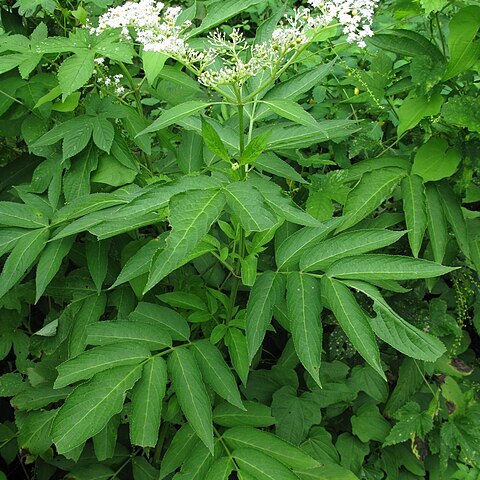Little branched, more or less weedy, erect shrub 1-3½ m. Pith white. Twigs terete, nodes between the petioles often with recurved, rarely foliaceous, stipular appendages. Leaflets 2-6-jugate, higher ones often 1-3-foliolate, rachis often with foliaceous appendages at the base of the leaflets, uppermost leaflets very rarely adnate to the terminal leaflet and the rachis. Leaflets oblong to linear-lanceolate, shortly stalked to sessile, sometimes adnate to the rachis, base cuneate to cordate, symmetric to oblique, mostly opposite, rarely alternate, apex acuminate, shallowly serrate, lower teeth glandular-swollen, 7-22 by 1½-6½ cm; midrib and base of side-nerves hairy above, hairy or glabrous beneath. Corymbs flat-topped, 3—5—(7—) rayed, mostly hairy to subglabrous, with a foliate base, near the branching often with stalked glands. Part of the flowers deformed into erect, stalked, yellow, orange or sometimes (?) green, top-shaped, persistent, nectaries, 3 mm diam., impressed at the top1. Pedicels 0-2 mm. Calyx-tube sulcate lengthwise, lobes triangular, acute, persistent, ½ mm. Corolla white or creamy, fragrant (as in S. nigra), (1½-)2½-3½ mm long, lobes acute, valvate in bud, (1-)2-2½ mm. Filaments mostly ± ½ mm, as long as the yellow anthers not exceeding the corolla-lobes, the latter spreading, rarely reflexed. Stigmas 3, narrowed towards the apex. Ovary 3-celled, sulcate. Ripe berry ovoid, black, 3-seeded, 3-4 mm diam. Seeds ovate, pointed 2 mm long.
More
Herbs, suffrutescent, or low shrubs, 1-2 m tall. Stem obviously striate; pith white; lenticels inconspicuous. Leaves imparipinnate; stipules leaflike or sometimes reduced to blue glands; lateral leaflets 2 or 3 pairs, alternate or opposite, narrowly ovate, 6-13 × 2-3 cm, adaxially sparsely pubescent when young, base obtuse and oblique, margin serrulate, often with 1 to several glandular teeth from below middle nearly to base, apex long acuminate; terminal leaflet ovate or obovate, base cuneate, sometimes connected with next lower leaflets, basal pair of leaflets shortly petiolulate; stipules of leaflets absent. Inflorescences terminal, compound umbellate cymes, lax, pedunculate, with leaflike bracts at base of peduncle, with 3-5 slender rays, with sparse yellow pubescence. Some flowers modified into persistent urceolate nectaries. Flowers: calyx tube urceolate, lobes triangular; corolla white, connate at base; anthers yellow or purple; ovary locules 3; styles short or nearly absent; stigma 3-lobed. Fruit red, subglobose, 3-4 mm in diam.; pyrenes 3 or 4, ovoid, ca. 2.5 mm, verrucate. Fl. Apr-May(-Aug), fr. Aug-Sep.
An evergreen shrub. It grows 70-100 cm high. The roots are fibrous. The bark is brown. The leaves are 6-12 cm long and 2.5-3 cm wide. The flowers are small and white. The fruit are small and round. They are red when ripe.
Everwet primary and secondary forests, thickets, clearings, mostly in ± shaded localities, (350-)700-2000 m, fl. fr. Jan.-Dec. The nectaries have been actually found to contain honey. The habit has been described as 'straggling', but this is certainly incorrect.
More
Mountain slopes, forests, streamsides, grasslands at elevations of 300-2,600 metres in China. Everwet primary and secondary forests, thickets and clearings, mostly in more or less shaded localities, at elevations from 350-2,000 metres.
It is a tropical plant. It grows near streams and grasslands between 300-2,600 m above sea level in southern China. It grows by creeks and ponds and in humid areas. In Sichuan and Yunnan.
Wild areas on village outskirts and wasteland.
The fruit are eaten fresh. The fruit are also preserved, used in confectionary, or made into drinks. The stems, leaves and shoots are parboiled and eaten. The roots are parboiled and eaten.


